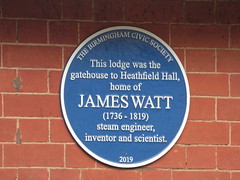Heathfield Hall
Commemorated on 1 plaque
This lodge was the gatehouse to Heathfield Hall, home of James Watt (1736 - 1819) steam engineer, inventor and scientist.
The Lodge - 33 Radnor Road, Handsworth, Birmingham, United Kingdom where it sited near (1789-1927)


